|
20TH CENTURY |

|
|
|
|
|
|
|
|
|
|
|
|
|
|
|
|
|
|
|
|
|
|
|
|
|
|
Copyright © Malcolm Fare 2005-2025
|
|
     
|
|
Alongside a large portrait by W Howard Robinson of Captain Alfred Hutton,
first President of the AFA, is a mannequin dressed like Hutton in a fine
herringbone pattern jacket and holding an epee and mask. Another mannequin
is dressed in the black silk jacket and skirt worn by a lady foilist
depicted in a 1920s painting entitled The Fencer by Isaac Cohen. A
self-portrait by Edgar Seligman demonstrates that the only man to win the
British championship at all three weapons twice was also a talented
artist. Other 20th century illustrations include a simple but
elegant woodcut of two lady foilists of the 1930s, an impressionist oil
painting of the Martini epee international and a dramatic photograph of
the 1988 Olympic epee final. |
|
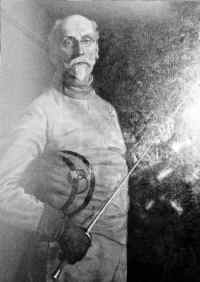
Capt. Alfred Hutton, 1910
|
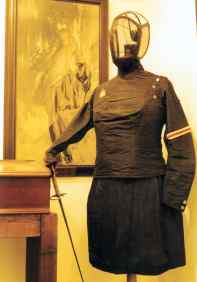
Black silk jacket and skirt, c. 1920
|
|
Up to the second world war fencing weapons continued to be made in a wide
variety of styles and among those on display are examples of the first
demountable sabre produced around 1910, an Italian epee dated 1915
inscribed as a gift from the great fencing master Agesilao Greco,
polished nickel-plated examples of all three weapons from the 1930s, epees
with triple points and with blades repaired with lead sheet, an early
electric epee with a quadruple-point tip and a Russian glassfibre foil
with plastic hilt – the lightest fencing weapon ever produced. |
|
|
|
|
|
|
|
|
|
|
|
|
|
|
|
|
|
|
|
|
|
|
|
|
|
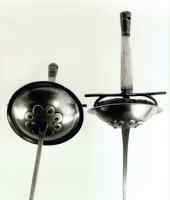
Italian bone-handled foils, c. 1915 |
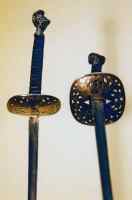
French presentation epees, c. 1920 |
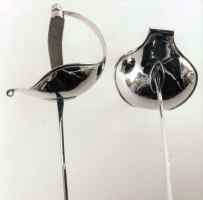
English chrome-plated sabres, c. 1930 |
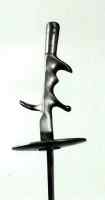
French Gardere-handled foil, 1932 |

Russian glassfibre foil, c. 1960 |

French fencing dummy c. 1900 |
|
Other curiosities include a French fencing dummy with a
flap in the chest that lifts to reveal a red cardboard heart, which makes
a target when swung like a pendulum; one of the first six electric boxes
made in Britain, still in working order after 50 years, donated by its
inventor Dr Ron Parfitt; and a Wilkinson sabre mould from the 1950s
together with a sabre blade blank, donated by Prof. John Sanders.
The earliest trophy in the museum is a silver pendant
awarded to a pupil of the Glasgow Academy in 1856. A collection of medals
won by Charles Newton-Robinson, who first made epee fencing popular in
England, includes a silver gilt plaque presented to members of the British
team at the international epee tournament of 1904 in Paris, his
participation medal at the 1906 Olympic Games and a commemorative gold
medal for the 1908 London Olympics.
Other trophies on display include an Edwardian brooch
in the form of a pair of silver foils crossed on a garland of leaves; a
silver watch-chain fob prize won in 1906 by Sir Haviland Le Mesurier; an
Oxford & Cambridge Boxing & Fencing Competition silver medal dated
1911; an Art Deco bronze medal presented in 1925, and a miniature silver
epee on a stand awarded to Sergeant L V Clarke for winning the Royal
Tournament epee competition in 1935. |
|
|
|
|
|
|
|
|
|
|
|
|
|
|
|
|
|
|
|
|
|
|
|
|
|
|
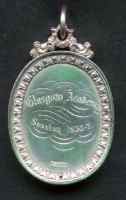
Scottish silver medal, 1856 |
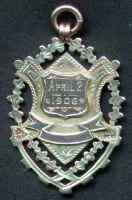
Silver prize, 1906 |
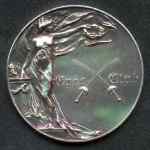
Savage Shield epee team silver medal, 1909
|
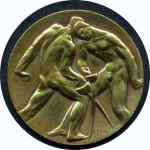
1925 Art Deco bronze medal |

English silver brooch,1902 |
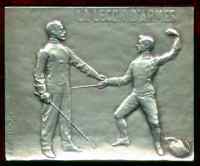
French silver plaque, c. 1900 |
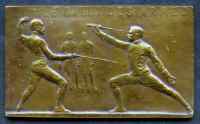
French bronze plaque, c. 1900 |
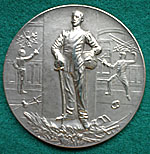
French silver medal, 1905 |
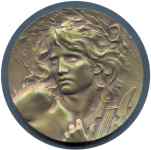
French bronze medal, Orpheus, 1904 |
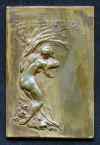
French bronze plaque, 1904 |
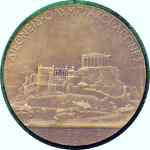
Olympic participation medal, 1906 |
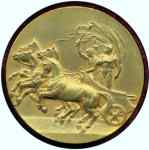
Olympic commemorative gold medal, 1908 |
|
Among the numerous examples of fencing ephemera that
can be seen is a lavish 12-page illustrated brochure produced for Mrs
Robert W Doyne’s At Home on January 13, 1902. This was billed as a
display between ladies and gentlemen to encourage fencing among women. A
special train was arranged from Paddington to Oxford with reduced fares
available on presentation of Mr Doyne’s visiting card. |
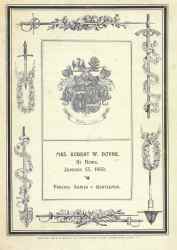
1902 |
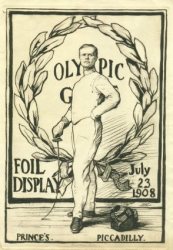
1908 |
|
Although the Olympic Games of 1908 only featured epee
and sabre, a programme shows that a special foil display was arranged
between pairs of fencers from 11 countries, including UK foil champions
John Jenkinson and Robert Montgomerie. Four years later a post-Olympic
programme published in Sweden included photographs of the British team at
all three weapons.
Another programme for an international fencing display
at Salle Bertrand in 1931 carries the signatures of the leading fencers of
the day, among them Gwen Neligan, Muriel Freeman, Archie Corble, P G Doyne,
Roger Crosnier, Emrys Lloyd, Leon Bertrand, Lieut-Col Ridley Martin,
Gordon Pilbrow and Sir Oswald Mosley, MP. |
|
|
|
|
|
|
|
|
|
|
|
|
|
|
|
|
|
|
|
|
|
|
|
|
|
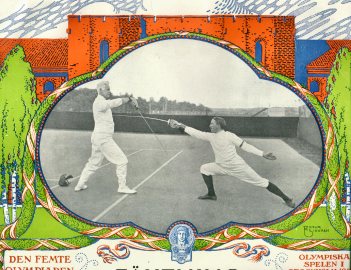
1912 |
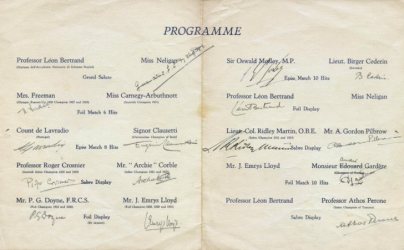
1931 |
|
In the first decade of the 20th century postcards became
popular and, in the form of Edwardian pin-ups, female fencers were soon
depicted on them. The collection includes two sets of French postcards
illustrating a quarrel between two women, followed by a duel with epees in
which the protagonists strip to the waist and are then reconciled after
one of them is slightly wounded. Of the many cards showing fencing in the
army, two particularly impressive examples show a bout on a narrow beam
about 6 m above the ground. |
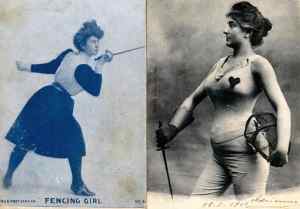
US & French pin-ups |
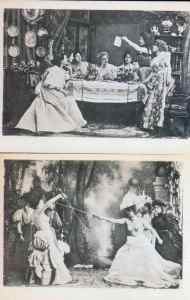
From a set of 16 |
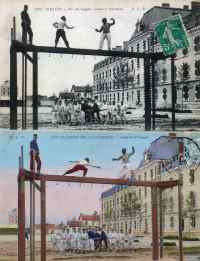
Fencing on a beam, 1904 |
|
British champions who were portrayed on postcards and cigarette cards
include Edgar Seligman, Stenson Cooke, Archie Corble, Gladys Davis and Ian
Campbell-Gray. Olympic gold medallist Gillian Sheen is shown on a stamp
from the Dominican Republic. |
|
|
|
|
|
|
|
|
|
|
|
|
|
|
|
|
|
|
|
|
|
|
|
|
      |